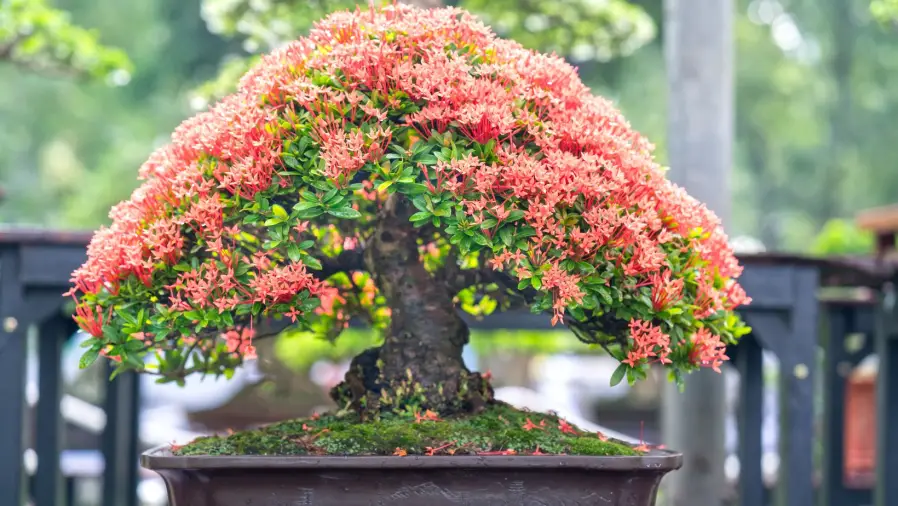Introduction
Bonsai trees are a captivating and elegant addition to any space, bringing a touch of nature’s artistry indoors. The art of cultivating bonsai involves careful and deliberate pruning, shaping, and nurturing of miniature trees. Many enthusiasts, especially beginners, often wonder, “Are bonsai trees hard to take care of?” n this guide, we will explore the realm of taking care of bonsai trees, uncovering both the delights and difficulties inherent in nurturing these miniature marvels.

Bonsai Trees: A Miniature Natural Wonder
Bonsai trees are not only ornamental plants; they are living sculptures that require a delicate balance of care and attention. Their unique charm lies in their ability to replicate the grandeur of full-sized trees on a small scale. From the mighty oak to the elegant cherry blossom, bonsai trees encompass a diverse range of species, each with its own specific care requirements.
The Delicate Balance: Bonsai Care Basics
Taking care of bonsai trees involves a blend of art and science. While it’s true that these miniature trees demand specialized care, it’s not an insurmountable task, especially with the right knowledge. Here are some key aspects to consider when caring for bonsai trees:
1. Choosing the Right Species
Selecting the appropriate tree species for your environment and skill level is crucial. Some species are hardier and more forgiving, making them ideal for beginners. Consider species like the Ficus or Juniper, which are known for their resilience.
2. Light and Temperature
Bonsai trees need the right balance of sunlight and shade. Place them near a window with indirect sunlight, as harsh sunlight can scorch their leaves. Additionally, be mindful of temperature fluctuations, as extreme cold or heat can stress the tree.
3. Watering Wisely
Proper watering is essential for bonsai care. The frequency of watering depends on factors such as the species, size of the pot, and weather conditions. It’s best to water thoroughly when the top inch of soil feels dry.
4. Pruning and Shaping
Regular pruning is necessary to maintain the bonsai’s desired shape and size. This helps channel the tree’s energy into growth where needed. Pruning during the dormant period of bonsai trees helps mitigate stress and promote healthy care.
5. Soil and Repotting
Quality soil ensures the proper drainage and aeration required for healthy root growth. Repotting every two to three years helps refresh the soil and prevent root binding.
Common Challenges and How to Overcome Them
While bonsai care can be rewarding, it comes with its share of challenges. Addressing these challenges promptly can contribute to the long-term health and beauty of your bonsai tree:
– Pests and Diseases
Bonsai trees can fall victim to pests and diseases, affecting their vitality. Stay vigilant for prevalent pests such as aphids and spider mites when caring for bonsai trees. Treat infestations promptly using natural or chemical solutions.
– Under or Over-Watering
One of the notable blunders in bonsai trees’ care is incorrect watering. Over-watering can result in root rot, whereas under-watering can induce dehydration. Establish a consistent watering routine and adjust based on the tree’s needs.
– Shaping Struggles
Shaping a bonsai tree requires patience and skill. Beginners might find it challenging to achieve the desired form. Taking a bonsai shaping workshop or seeking guidance from experienced enthusiasts can be immensely helpful.
– Winter Care
Winter can be particularly challenging, as the cold weather and dry indoor air can stress bonsai trees. Consider moving them to a sheltered area or using humidity trays to mitigate the effects of dry air.
Expert Tips for Bonsai Success
Achieving bonsai mastery takes time, but the journey is rewarding. Here are some expert tips to enhance your bonsai care skills:
- Study Your Species: Understand the specific needs of your chosen species to tailor your care routine accordingly.
- Patience Is Key: Bonsai trees grow slowly, and shaping them takes time. Exercise patience and enjoy the gradual transformation.
- Learn from Others: Join bonsai clubs, forums, and workshops to learn from experienced growers and share your experiences.
- Consistency Matters: Consistent care routines, from watering to pruning, are crucial for bonsai health.
- Adapt and Adjust: As seasons change, adapt your care routine to accommodate the tree’s evolving needs.

FAQs
Q: Can I keep a bonsai tree indoors?
A: Yes, many bonsai species can thrive indoors, provided they receive adequate light and care.
Q: How often should I fertilize my bonsai?
A: Fertilize your bonsai every two to four weeks during the growing season, using a balanced fertilizer.
Q: Can bonsai trees be grown from seeds?
A: While it’s possible, growing bonsai from seeds requires more time and expertise. Most enthusiasts prefer starting with young plants or pre-bonsai trees.
Q: Is bonsai shaping difficult for beginners?
A: Shaping bonsai requires practice, but with guidance and patience, beginners can achieve pleasing results.
Q: Are bonsai trees expensive to maintain?
A: While there are costs associated with tools, pots, and occasional workshops, bonsai care can be tailored to fit various budgets.
Q: Can I create my own bonsai pot?
A: Crafting bonsai pots requires skill and knowledge of pottery. It’s recommended to start with commercially available pots.
Conclusion
In conclusion, bonsai trees are a delightful endeavor that combines horticulture and artistry. While they do require attention and care, the question “Are bonsai trees hard to take care of?” need not discourage aspiring bonsai enthusiasts. With a genuine passion for these miniature wonders, a willingness to learn, and the expert advice provided in this guide, anyone can master the art of bonsai care. So, roll up your sleeves, gather your tools, and embark on a rewarding journey of nurturing these captivating living sculptures.
